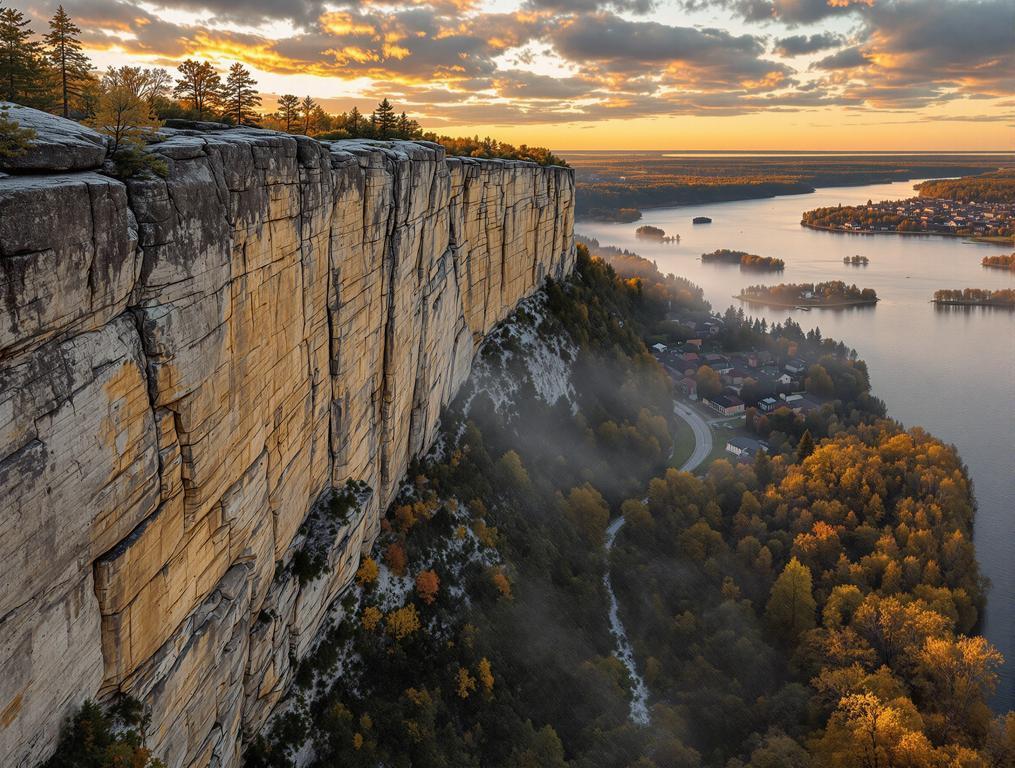I stand at the edge of Maiden Rock Bluff, 340 feet above Lake Pepin, where the wind carries whispers of a 200-year-old tragedy. Below me stretches the Mississippi River, glimmering in July sunshine, while behind me lies Stockholm, Wisconsin – population 82. This tiny village, just 70 miles southeast of Minneapolis, guards one of America’s most haunting love legends alongside its unexpected trove of Swedish heritage.
My fingers trace the weathered informational plaque that tells the story of Winona, a Dakota maiden who chose death over a forced marriage, leaping from this very limestone precipice. The tale feels both ancient and immediate in this place where time moves differently.
The Tragic Legend That Haunts America’s Smallest Art Village
Stockholm’s residents have preserved the story of Winona’s Leap for over two centuries. The legend tells of a young Dakota woman who fell in love with a trader from a rival tribe – a relationship her father forbade. Rather than marry the chief her father selected, Winona escaped to this bluff and jumped to her death.
Unlike the fictional tales that populate small-town America, this legend is anchored in documented regional history. Similar to how this Kentucky town inspired a pivotal American novel, Stockholm has become the custodian of a narrative that illuminates our complex cultural past.
The bluff itself is now protected as a State Natural Area, preserving both the geological formation and the cultural memory it holds. Walking its trails feels like stepping through pages of unwritten history – a rare sensation in our modern, documented world.
How 82 Residents Preserve a 200-Year-Old Mystery
Stockholm’s population would barely fill a small apartment building, yet these 82 residents maintain four art galleries, a winery, and multiple cultural sites. This gives the village the highest per-capita cultural density I’ve encountered in rural America.
Similar to this Missouri town preserving historic architecture, Stockholm demonstrates how small communities can serve as powerful cultural guardians. The village nearly vanished in the mid-20th century before artists discovered and revitalized it in the 1970s.
“When you live in a place this small, stories become your currency. We pass them down like heirlooms. Winona’s story reminds us that this land held meaning long before our buildings stood here.”
The irony isn’t lost on me – a village founded by Swedish immigrants in 1854 now preserves a Dakota legend with the same reverence it does its Scandinavian heritage. In Stockholm’s half-square-mile footprint, these seemingly disparate cultural threads have become beautifully interwoven.
Where Swedish Immigrants and Dakota Heritage Converge
Stockholm’s artistic renaissance mirrors other artisanal havens like this Virginia town where craft production thrives despite small populations. What makes Stockholm unique is this cultural duality – Swedish-inspired architecture housing galleries that often showcase Native American themes.
The limestone formations of Maiden Rock Bluff parallel those found in European villages like this French settlement beneath the Pyrenees, creating a landscape that feels both foreign and quintessentially American. This geographic convergence helped make Stockholm a natural gathering place for diverse cultures.
At Stockholm General, I sample local maple cream while browsing pottery inspired by both Scandinavian design and Indigenous patterns. This cultural fusion feels organic rather than contrived – the natural evolution of a place where diverse traditions have had two centuries to harmonize.
Experiencing Winona’s Leap in Summer 2025
July visitors can access Maiden Rock Bluff via a 1.2-mile hiking trail that begins at the designated parking area on County Road AA. The moderate climb rewards with panoramic views across Lake Pepin’s 2-mile width – the broadest natural section of the Mississippi.
The best time to visit is early morning when the bluff catches golden light and before summer humidity builds. July visitors can experience both cultural immersion and natural beauty, similar to how this Colorado town offers spectacular summer wildflowers.
Stockholm’s Summer Art Fair typically falls on the third weekend of July, when the village’s population temporarily swells from 82 to nearly a thousand. Despite this growth, the experience remains intimate – as if you’ve stumbled upon a family gathering rather than a tourist attraction.
As I drive back along the Great River Road, the Mississippi gleaming to my right, I can’t help but think that Stockholm has accomplished something remarkable. In this tiny village, a Swedish-American community has become the unlikely guardian of a Dakota legend, preserving both cultural memories in a place that feels suspended between worlds. Some might call it the Stockholm syndrome of small-town America – falling in love with the very histories that once seemed destined to vanish.
